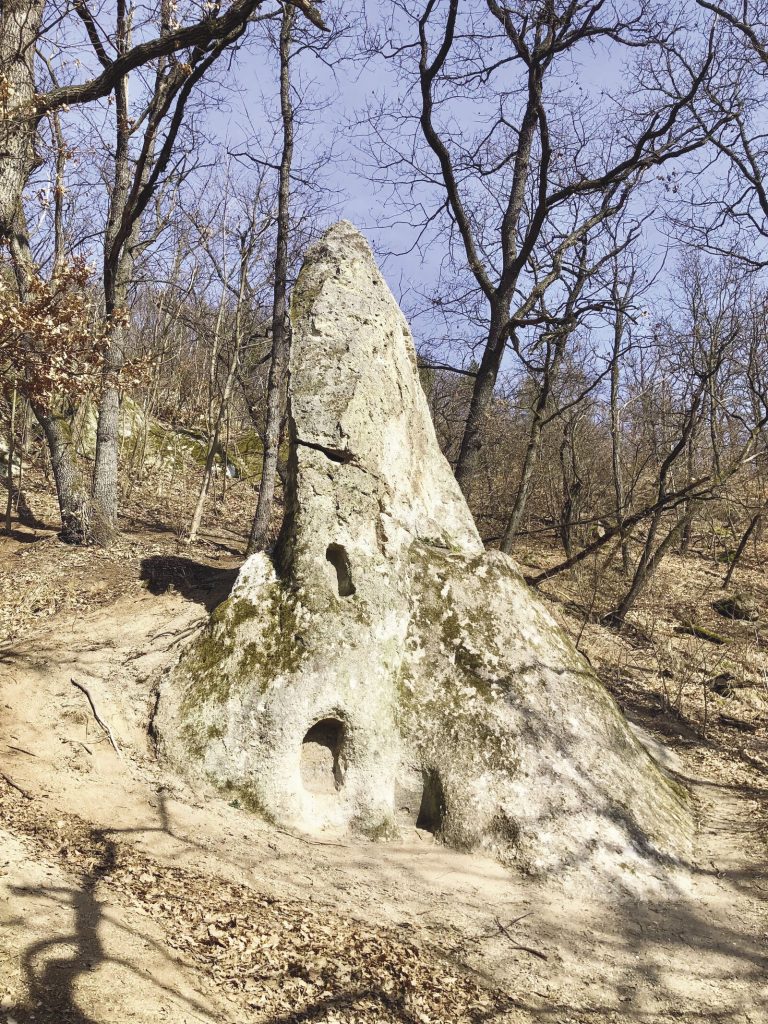Deep within the dense forests of the Bükk Mountains in northern Hungary, an extraordinary monument rises from the earth — a sharp, conical stone known as the “Stone Sentinel.” Located near the village of Szomolya, this ancient carving has long stirred both scholarly curiosity and local legend. It stands on a forested slope covered in volcanic tuff, its surface worn by time yet still bearing the deliberate marks of human hands. Although villagers had known of its existence for centuries, it was not until the 1970s that the monument drew scientific attention, when Dr. Gábor Székely of the Hungarian Academy of Sciences began the first systematic survey of rock sanctuaries scattered throughout northern Hungary. His discovery transformed a curious local landmark into one of the country’s most intriguing archaeological enigmas.

Dating methods remain uncertain, but most experts believe the monument was created between the 6th and 9th centuries CE, during the early Medieval period, long before Hungary’s Christianization. Others suggest an even earlier origin, possibly the Late Bronze Age (1200–800 BCE), when proto-European tribes inhabited the Carpathian Basin. Its exact age may never be known, yet this ambiguity lends it a haunting beauty — a relic poised between myth and history, where time itself seems carved into stone.
The Stone Sentinel was hewn directly from solid volcanic tuff, a relatively soft rock ideal for shaping when freshly exposed. Rising roughly 2.5 meters high, its form narrows into a pointed peak, almost like a natural pyramid born from the hillside. Two rectangular niches, carefully cut into its west-facing surface, pierce the stone like silent windows. Each niche measures about 30 centimeters deep, their interiors smoothed by the rhythmic precision of early chisels. Geological surveys reveal that these cavities could not have formed through natural erosion; their symmetry and consistent depth indicate deliberate craftsmanship. When examined closely, faint tool marks remain visible — echoes of ancient artisans who, with primitive instruments of metal or stone, transformed raw geology into sacred geometry.

Scholars have long debated the purpose of these enigmatic hollows. In Hungarian, such monuments are called “kaptárkövek”, literally “beehive stones,” due to their honeycomb-like niches. Yet their true function seems far more spiritual than practical. Local folklore speaks of them as shrines of the old faith, places where offerings were made to nature deities or to the spirits of ancestors. During solstices, sunlight is said to strike the openings at precise angles, suggesting an astronomical alignment connected to solar worship. The ancient people who carved them may have viewed these stones as gateways between worlds, where earth, sun, and spirit converged in eternal dialogue.
Archaeologists have found similar carved monoliths throughout the Bükk and Mátra mountain ranges — more than 470 in total. Dr. Székely’s groundbreaking work, later published in his 1981 volume Ancient Rock Sanctuaries of Northern Hungary, documented their distribution and possible functions. Many are aligned with natural springs, burial mounds, or ancient pathways, hinting at a network of ritual landscapes that once stretched across the Carpathian Basin. In some cases, traces of ashes and ceramic fragments were discovered near the base of the stones, possibly remnants of burned offerings or funerary rites. This has led some researchers to interpret the kaptárkövek as memorial stones, sacred markers of the ᴅᴇᴀᴅ or symbolic vessels for rebirth — where the living communed with the beyond through carved stone and firelight.

In recent decades, researchers from Eötvös Loránd University have employed 3D laser scanning and pH๏τogrammetry to study the carvings in minute detail. These digital models revealed intentional alignment patterns corresponding to the path of the sun and moon, strengthening the theory of their cosmic significance. Conservation efforts have also intensified: the Hungarian National Heritage Office now classifies these monuments as protected cultural relics, and forest authorities regulate access to ensure their preservation. The “Stone Sentinel” of Szomolya remains one of the most pristine examples, its sharp peak and perfectly cut niches remarkably intact despite centuries of exposure to wind, frost, and rain.

Culturally, the “Stone Sentinel” embodies more than an archaeological curiosity — it represents humanity’s timeless urge to shape meaning from nature. It stands as a bridge between prehistoric spirituality and modern scientific wonder, a meeting point of myth and material. Its form evokes both natural grace and deliberate purpose, a testament to a worldview in which the landscape itself was sacred and alive. While we may never know the names or language of those who carved it, their silent devotion endures in every curve and crevice.
As Dr. Székely once wrote, “In these stones lies the heartbeat of an ancient world — a pulse that has never ceased.” The Stone Sentinel, emerging from the leaf-strewn earth of the Bükk forests, continues to guard that heartbeat. It reminds us that long before temples or written words, our ancestors found their gods in stone and sunlight — and that, perhaps, we are still learning to listen to what they left behind.